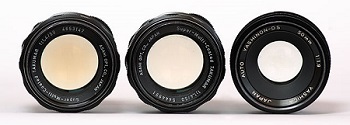A little over a decade ago I got a phone call asking me what I knew about thorium. Not much as it turned out – that part of the call didn’t last long. But it led to an interesting consulting project that let me delve into the manufacture of high-quality optical glass and the Second World War (among other things).

In the first part of the 20th century the highest-quality optics were made in Germany, and even American military suppliers were buying their optical glass from the Germans – lenses that went into periscopes, telescopes, and pretty much anything else that depended on lenses. Part of what made German glass so good was its clarity and its refractive index, both of which were enhanced by adding materials to the glass. Just as dissolving lead into molten glass gives it the clarity, shine, and sparkle of lead crystal, the addition of thorium does the same, making it possible to fabricate thinner and lighter lenses. At the same time, the properties of thorium help to reduce the dispersion of different wavelengths of light (the different colors) as they pass through the glass. The first patents for thoriated glass lenses were issued in 1939 or so with additional patents issued through the 1940s and 1950s. And that led to my phone call, albeit a half-century later.
In the 1930s, when Germany was starting to get a little frisky the American military realized that they might need to find a more reliable supplier for their high-quality optics, so they began contracting with American lens-makers. This led to our becoming self-sufficient in this area. And, in the case of my client, it required a bit of cleanup about 15 years ago.
See, in order to make a lens the manufacturer starts off by pouring glass to form a blank – a piece of glass with the general shape of a lens, just as baseball bat starts with a piece of cylindrical wood of roughly the correct dimensions. And, just as the excess wood is removed by a lathe, the extra glass is ground off using a sort of slurry that contains the grinding compound. The glass that was removed, though, contains thorium. In the 1940s this wasn’t much of a problem – the regulations pertaining to thorium were not very strict. But in the last few decades of the 20th century this began to change and places that hadn’t required much attention earlier were now a potential concern. Which meant that my client needed to have their site surveyed and some subsurface tanks checked to see if they contained any thoriated glass residue (to cut to the chase, they did).
Of course, any lens could benefit from the addition of thorium, and after the war ended it started finding its way in to consumer products – primarily into lenses for high-end cameras. Over the years a number of manufacturers began making thoriated lenses, a practice that continued into the 1980s. And, while such lenses are no longer being made, there are still some around for those who are lucky enough to find them.
My client’s thorium-contaminated site needed to be cleaned up, even though the thorium posed no health risk to anybody. Similarly, while it’s easy enough to get radiation measurements from a thoriated camera or periscope lens from that era, the radiation dose rates are not high enough to cause harm to those using them – with the possible exception of workers who spend many hours weekly looking through thoriated glass eyepieces on microscopes, telescopes, and the like.
It also turns out that thorium is fairly versatile. I have a small container of thoriated welding electrodes that I use for demonstrations when I teach radiation safety classes – the thorium is used for its metallurgical properties just as it used to be alloyed in the metal from which jet turbine blades were made. I also have some gas lantern mantles that contain thorium; these aren’t made much in the US today, although there are still some overseas manufacturers. And then there’s the thoriated toothpaste that I wrote about in an earlier posting. These have all led to lengthy cleanups around the world, including a number in the US.
My last contact with thorium came about 7 or 8 years ago when I was characterizing a thorium-contaminated site for the NYC Health Department – this time working for the City. In this case the thorium was an afterthought – the facility used to produce rare earth elements (back in the 1930s and 1940s), the ores of which were contaminated with thorium. It turns out that thorium is very similar geochemically to rare earths so most rare earth ores also have some thorium in them. Interestingly, in this case the company began producing thorium to sell to the Atomic Energy Commission – thorium went from being waste to being a product. For awhile the government was looking into using thorium for nuclear reactor fuel. That idea was never really pursued vigorously in the US, although I’ve heard rumors that India and China might be looking into it.
Thorium reactors, though, start to get a little complicated and this piece has already covered enough ground – from Germany to the US; from military optics to cameras, welding rods, and jet engines; and from additive to waste to fuel.